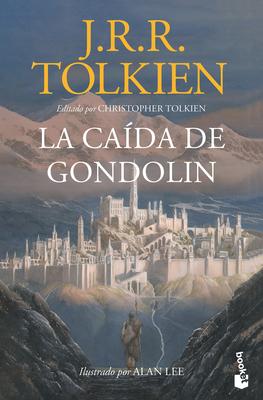Conclusin de los Relatos de la Tierra Media que conforman una de las grandes obras de Tolkien, El Silmarillion.
La Cada de Gondolin fue, en palabras de J. R. R. Tolkien, la primera historia real de ese mundo imaginario y constituye uno de los tres Grandes Relatos de los Das Antiguos.
En La Cada de Gondolin chocan dos de los principales poderes. Morgoth, el mal ms absoluto, controla un enorme poder militar. En su profunda oposicin est Ulmo, Seor de las Aguas, quien trabaja para apoyar a los Noldor, el grupo de elfos entre los que se contaban Hrin y Trin Turambar. En el centro de este con-flicto se encuentra la ciudad de Gondolin, bella pero oculta. Fue construida por elfos Noldor que se rebelaron contra el poder divino y huyeron a la Tierra Media. Turgon, el rey de Gondolin, es el principal objeto tanto del odio como del miedo de Morgoth, quien trata de descubrir la ciudad escondida.
En este mundo entra Tuor, el primo de Trin, como instrumento para hacer cumplir los planes de Ulmo. Guiado por el dios emprende un viaje en busca de Gondolin. En esta ciudad Tuor madura; se casa con Idril, hija de Turgon, y tienen a su hijo Erendel.
Debido a un acto de traicin, Morgoth localiza la ciudad y lanza un ataque devastador. Tras el relato de la cada de Gondolin, Tuor y su familia huyen y contemplan las ruinas de su ciudad en llamas. Viajan hacia otra historia, el Cuento de Erendel. Tolkien nunca lleg a escribirla, pero en el presente libro se incluye un esbozo de sta.
ENGLISH DESCRIPTION
"An essential historical reference for Middle-earth fans". Entertainment Weekly
The Fall Of Gondolin is the final work of J.R.R. Tolkien's Middle-earth fiction, completing Christopher Tolkien's life-long achievement as the editor and curator of his father's manuscripts.
In the Tale of The Fall of Gondolin are two of the greatest powers in the world. There is Morgoth of the uttermost evil, unseen in this story but ruling over a vast military power from his fortress of Angband. Deeply opposed to Morgoth is Ulmo, second in might only to Manw, chief of the Valar. Central to this enmity of the gods is the city of Gondolin, beautiful but undiscoverable. It was built and peopled by Noldorin Elves who, when they dwelt in Valinor, the land of the gods, rebelled against their rule and fled to Middle-earth. Turgon King of Gondolin is hated and feared above all his enemies by Morgoth, who seeks in vain to discover the marvellously hidden city, while the gods in Valinor in heated debate largely refuse to intervene in support of Ulmo's desires and designs.
Into this world comes Tuor, cousin of Trin, the instrument of Ulmo's designs. Guided unseen by him Tuor sets out from the land of his birth on the fearful journey to Gondolin, and in one of the most arresting moments in the history of Middle-earth the sea-god himself appears to him, rising out of the ocean in the midst of a storm. In Gondolin he becomes great; he is wedded to Idril, Turgon's daughter, and their son is Erendel, whose birth and profound importance in days to come is foreseen by Ulmo.
At last comes the terrible ending. Morgoth learns through an act of supreme treachery all that he needs to mount a devastating attack on the city, with Balrogs and dragons and numberless Orcs. After a minutely observed account of the fall of Gondolin, the tale ends with the escape of Trin and Idril, with the child Erendel, looking back from a cleft in the mountains as they flee southward, at the blazing wreckage of their city. They were journeying into a new story, the Tale of Erendel, which Tolkien never wrote, but which is sketched out in this book from other sources.
Following his presentation of Beren and Lthien Christopher Tolkien has used the same 'history in sequence' mode in the writing of this edition of The Fall of Gondolin.
In the words of J.R.R. Tolkien, it was 'the first real story of this imaginary world' and, together with Beren and Lthien and The Children of Hrin, he regarded it as one of the three 'Great Tales' of the Elder Days.
